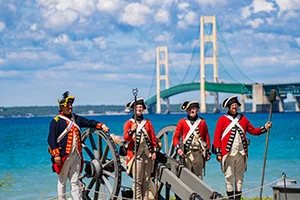As Michigan celebrates its 180th birthday, let’s take a look at the treaty that gave us much of the Michigan we know today. Without the 1836 Treaty of Washington, an agreement between the U.S. government and the Anishinaabek people, Michigan could never have become a state on January 26, 1837.


The treaty was signed on March 28, 1836 in Washington D.C. by Henry Schoolcraft, Indian Commissioner for the United States, and representatives of the Odawa and Ojibway nations of Native Americans, who referred to themselves collectively as the Anishinaabek. The tribes ceded an area of 13,837,207 acres in the northwest portion of the Lower Peninsula and the eastern portion of the Upper Peninsula. In return, the treaty guaranteed the Anishnaabek permanent reservation lands and perpetual access to natural resources, including hunting and fishing rights. The United States agreed to pay for the land and provide additional services, including use of a dormitory constructed on Mackinac Island.
Unfortunately, Congress altered the terms of the treaty after the Odawa and Ojibway representatives left Washington. Instead of permanent rights to the ceded land, the Anishinaabek found that the final treaty guaranteed them only five years before the government could consider forcibly removing them from northern Michigan. Schoolcraft endorsed removal only two years after the treaty was signed. The Odawa and Ojibway successfully fought against removal, and secured their claims in northern Michigan through the 1855 Treaty of Detroit. More recently, tribal fishermen called upon the provisions of the Treaty of Washington to protect their traditional fishing rights on the Great Lakes.
The area ceded to the U.S. government by the 1836 Treaty of Washington represents almost 40% of the current land area of the state of Michigan. Without this land, the Michigan Territory could not have been granted statehood and admitted to the Union.









